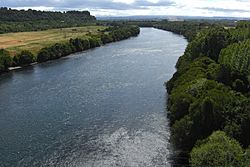Battle of Río Bueno (1654) facts for kids
Quick facts for kids Battle of Río Bueno |
|||||||
|---|---|---|---|---|---|---|---|
| Part of Arauco War | |||||||
|
|||||||
| Belligerents | |||||||
|
Mapuche-Huilliche |
|||||||
| Commanders and leaders | |||||||
| Strength | |||||||
| 900 Spanish soldiers 1500 Indian auxiliaries |
3000 Mapuche-Huilliches | ||||||
| Casualties and losses | |||||||
| About 100 soldiers lost 200 auxiliaries lost |
Few | ||||||
The battle of Río Bueno (Spanish: Batalla de Río Bueno or Desastre de Río Bueno) was fought in 1654 between the Spanish Army of Arauco and indigenous Cuncos and Huilliches of Fütawillimapu in southern Chile. The battle took place against a background of a long-running enmity between the Cuncos and Spanish, dating back to the destruction of Osorno in 1603. More immediate causes were the killing of Spanish shipwreck survivors and looting of the cargo by Cuncos, which led to Spanish desires for a punishment, combined with the prospects of lucrative slave raiding.
While Cuncos and Jesuits made attempts to placate the mood of war, maestre de campo Juan de Salazar eventually convinced Governor of Chile Antonio de Acuña Cabrera to authorise and support his expedition. The battle was fought across Bueno River where Cuncos and Huilliches repelled Spanish attempts to cross the river, resulting in hundreds of Spanish troops drowned or killed. The battle contributed to usher the Mapuche uprising of 1655, in which many Spanish settlements and haciendas were ravaged.
The Battle of Río Bueno along with the subsequent events led to a political crisis among the Spanish in Chile, which involved a risk of civil war. The severity of the crisis made Miguel Luis Amunátegui list it among the precursors to the independence of Chile. The Cuncos and Huilliches south of Bueno River remained de facto independent until the late 18th century.
Battle
The Spanish expedition started from the fort of Nacimento in La Frontera with a force of 900 soldiers and 1500 Indian auxiliaries.
The Spanish reached the northern shores of east-to-west flowing Bueno River on 11 January 1654. To cross the river, Salazar ordered the construction of a pontoon bridge. Local Mapuche-Huilliches had been warned in advance of the Spanish advance south, so they concentrated in large numbers on the opposite shore of the river. The Mapuche-Huilliche had brought women and children with them, but they remained hidden in the forest, as did also most of the men, only the ones on horseback revealing themselves to the Spanish. In total, Mapuche-Huilliche forces numbered about 3000 men armed primarily with lances.
Some veteran officers expressed their doubts about Salazar's plans, including the stability of the bridge. As the pontoon bridge stood ready, Juan de Salazar sent a first force across. About 200 soldiers that had crossed were quickly surrounded and were being routed, so Salazar ordered the other soldiers to speed up their march across the bridge. However, the bridge was not stable enough and at this point broke apart with disastrous consequences for the Spanish. Altogether, the Spanish lost a hundred professional soldiers and two hundred auxiliaries in a battle where the actual fighting was very limited. Despite these losses, the surviving Spanish managed to get back north to their bases without harassment from the Mapuche.
Aftermath
When learning about the defeat, governor Acuña Cabrera ordered an investigation into any military misconduct during the campaign. However, Salazar's sister Juana de Salazar, who was the wife of the governor, arranged for witnesses to justify her brother's conduct. The investigation concluded by recommending that Juan de Salazar be granted the command of a larger army to chastise the Cuncos and allow Salazar to "recover his honour".
The planning of a second expedition in the summer of 1655 contributed to unleash a large Mapuche uprising that year.


